

Passively safe reactors rely on nature to keep them cool. Imagine a nuclear power plant so safe that even the worst emergencies would not damage the core or release radioactivity.

And imagine that this is achieved not with specially engineered emergency systems, but through the laws of nature and behavior inherent in the reactor's materials and design. This goal, known in the nuclear industry as "passive safety," is pursued and even claimed by a number of reactor concepts. Argonne's advanced fast reactor (AFR) has demonstrated its passive safety conclusively on a working prototype. "Back in 1986, we actually gave a small prototype advanced fast reactor a couple of chances to melt down," says Argonne nuclear engineer Pete Planchon, who led the 1986 tests. "It politely refused both times. " The 500MW molten salt nuclear reactor: Safe, half the price of light water, and shipped to order.
Nuclear power basically comes down to two issues: Safety and cost.
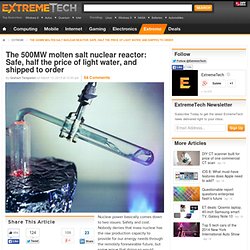
Nobody denies that mass nuclear has the raw production capacity to provide for our energy needs through the remotely foreseeable future, but some argue that doing so would either bankrupt us, sicken us, or both. While this is certainly a disputed interpretation, it’s one that has been gathering support in the wake of the Fukushima disaster and a prolonged PR campaign from coal, natural gas, and certain wings of the environmentalist movement. As a result, the conventional nuclear industry, floundering due to widespread public unease and growing legislative opposition, seems to be begging for a revolution. Can Innovation Help Bring Down Cost of New Nuclear Power Plant? Is it safe?
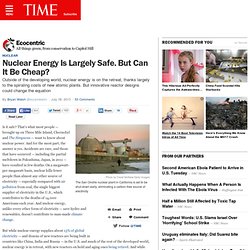
That’s what most people — brought up on Three Mile Island, Chernobyl and The Simpsons — want to know about nuclear power. And for the most part, the answer is yes. Accidents are rare, and those that have occurred — including the partial meltdown in Fukushima, Japan, in 2011 — have resulted in few deaths. On a megawatt-per-megawatt basis, nuclear kills fewer people than almost any other source of electricity — especially compared with air pollution from coal, the single biggest supplier of electricity in the U.S., which contributes to the deaths of 14,000 Americans each year.
And nuclear energy, unlike every other form of electricity — save hydro and renewables, doesn’t contribute to man-made climate change. A New Way to Do Nuclear - The New Yorker. In February of 2010, Leslie Dewan and Mark Massie, two M.I.T. students, were sitting on a bench in a soaring marble lobby under the university’s iconic dome.
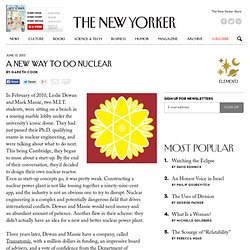
They had just passed their Ph.D. qualifying exams in nuclear engineering, and were talking about what to do next. This being Cambridge, they began to muse about a start-up. By the end of their conversation, they’d decided to design their own nuclear reactor. Even as start-up concepts go, it was pretty weak.
Advanced Nuclear Power Reactors. (Updated May 2015) Improved designs of nuclear power reactors are constantly being developed internationally.The first so-called Generation III advanced reactors have been operating in Japan since 1996.

These have now evolved further.Newer advanced reactors now being built have simpler designs which reduce capital cost. Generation IV Nuclear Reactors: WNA. (Updated August 2015) An international task force is developing six nuclear reactor technologies for deployment between 2020 and 2030.
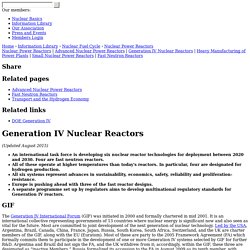
Four are fast neutron reactors.All of these operate at higher temperatures than today's reactors. In particular, four are designated for hydrogen production.All six systems represent advances in sustainability, economics, safety, reliability and proliferation-resistance.Europe is pushing ahead with three of the fast reactor designs.A separate programme set up by regulators aims to develop multinational regulatory standards for Generation IV reactors.
The Generation IV International Forum (GIF) was initiated in 2000 and formally chartered in mid 2001. It is an international collective representing governments of 13 countries where nuclear energy is significant now and also seen as vital for the future. GIF focus Most of the six systems employ a closed fuel cycle to maximise the resource base and minimise high-level wastes to be sent to a repository. Does nuclear power lead to weapons proliferation? Email Prior to reading this article, it is recommended that you read our basic definitions for discussing nuclear science.
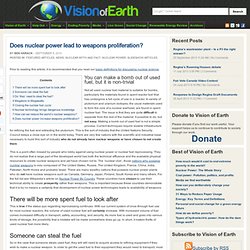
You can make a bomb out of used fuel, but it is non-trivial Not all used nuclear fuel material is suitable for bombs, particularly the materials found in spent reactor fuel that has undergone a full cycle of use in a reactor. A variety of plutonium and uranium isotopes, the usual materials used to form the core of a nuclear warhead, are found in spent nuclear fuel.
The issue is that they are quite difficult to separate from the rest of the material. What is nuclear? / Thorium As Nuclear Fuel: the good and the bad. Thorium is a basic element of nature, like Iron and Uranium.
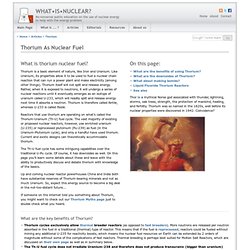
Like Uranium, its properties allow it to be used to fuel a nuclear chain reaction that can run a power plant and make electricity (among other things). Thorium itself will not split and release energy. Rather, when it is exposed to neutrons, it will undergo a series of nuclear reactions until it eventually emerges as an isotope of uranium called U-233, which will readily split and release energy next time it absorbs a neutron. Thorium is therefore called fertile, whereas U-233 is called fissile. Reactors that use thorium are operating on what’s called the Thorium-Uranium (Th-U) fuel cycle. The Th-U fuel cycle has some intriguing capabilities over the traditional U-Pu cycle. Thorium and the dream of clean nuclear power.
HONG KONG (Reuters) - China isn't alone in turning to thorium as a potential source of power.
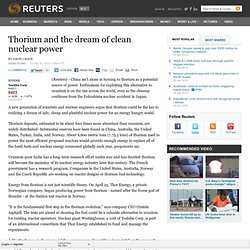
Enthusiasm for exploiting this alternative to uranium is on the rise across the world, even as the cleanup continues from the Fukushima nuclear accident in Japan. A new generation of scientists and nuclear engineers argue that thorium could be the key to realizing a dream of safe, cheap and plentiful nuclear power for an energy hungry world. Thorium deposits, estimated to be about four times more abundant than uranium, are widely distributed: Substantial reserves have been found in China, Australia, the United States, Turkey, India, and Norway. Converting a civilian enrichment plant into a nuclear weapons material facility.
Iran’s nuclear program—specifically its ongoing uranium enrichment—has long been the subject of much debate.

Iran insists its enrichment is peaceful, but the international community worries that Iran could be seeking to acquire a nuclear weapon. But exactly how can a civilian enrichment plant be turned into one that produces nuclear weapons material? There are two paths to a bomb: using either uranium or plutonium. Alyn Ware: Nuclear Energy and Weapons: Uncontrollable in Time and Space. The earthquake and tsunami in Japan devastated a whole region. Radioactive emissions from the damaged nuclear reactors are very serious, and have already contaminated food and water, prompting a ban on food exports from four prefectures and a government warning not to give Tokyo tap water to babies. The crisis could impact human health and the environment on an even wider scale -- across Japan and around the globe.
Whether or not the brave technicians in Fukushima are successful in containing the bulk of the radiation in the six reactors, the message is clear: natural disasters and accidents will happen. Effects of Nuclear Power on Public Health: From Three Mile Island to Fukushima. Three Mile Island. Chernobyl. Fukushima. Since the beginning of the Atomic Age, the use of nuclear energy technologies has been accompanied by numerous crises and persistent public health concerns. Currently, nuclear power has become an indispensable part in the ongoing search for alternative energy sources. Nuclear Energy Information Centre - Environmental Effects of Nuclear Power. Environmental Effects of Nuclear Power In considering environmental effects, let's look at the effects on air, water, ground, and the biosphere (people, plants, and animals) - and let's also look at what can and is being done to minimize those effects.
In the United States, it is important to realize that the law - Title 10 Code of Federal Regulations (CFR), Part 20 - governs any radioactive releases from nuclear power plants. If you want to find any federal regulation by title and part, use the Title 10 CFR Index or National Archives & Records Administration (for all sections of the Code of Federal Regulations).
This section addresses commercial nuclear reactors regulated by the NRC (or similar agencies in other countries) and does not address the myriad of effects due to government activities, e.g. at Hanford, where the Hanford Tanks Initiative is correcting problems stemming from activities in the 1940's to 1970's timeframe. Air- Gaseous Releases. Environment - Nuclear Energy. Introduction The environmental effects of nuclear power exploitation have been a central point of the debate over the feasibility of nuclear power in the near future. Green house gas emissions are considered to be one of the key contributors to global climate change. Nuclear power plants release close to zero green house gasses directly. It is their biggest advantage over conventional coal power plants. However, indirect emissions associated with power plant operations are significant.